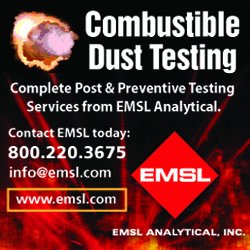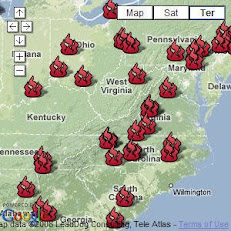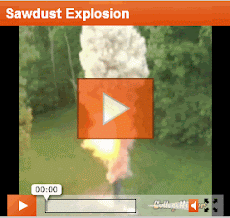I'd like to share this post that was authored by Robert Zuiderveld, General Manager at Pyroban Corp in the ComDust discussion group.
The recent Forkliftaction.com article by contributing editor Tom Andel,"Keeping forklifts out of explosive situations," clearly illustrates that the majority of stakeholders do not understand the complexities involved in or consequences resulting from operating non- compliant powered industrial equipment in potentially explosion hazardous areas. Even though I appreciate the attention the article is putting on the issues at hand I am concerned with some in the information and statements published in the article.
CAL-OSHA
According to the OSHA IMIS citation and violation data, CAL-OSHA has not written a single OSHA 1910.178. C01 or C02 citation between Jan 1, 2003 and the present. Yet according to the NFIRS data approximately 432 fires were started by powered industrial equipment in California between 2003 and 2007.
As a matter of fact OSHA regions 9 and 10 (entire West Coast region) experienced approximately 600 and 742 fires respectively (according to the NFIRS), while only one (1) OSHA 1910.178. C01 citation was written (Nevada in 2003) between Jan 1, 2003 and the present in both regions.
I can only wonder why CAL-OSHA publishes an article about equipment fire and explosion safety while they appear to have completely ignored enforcement of the issue for at least 6 years?
Lack of Ex Hazard Awareness
I also have to question these statements:
“The problem is it’s not easy or cheap to find replacements,” he says. “For example, an electric forklift designed for heavy use in an outdoor location is not easy to come by. A number of my clients are concerned because they’ve been cited for having unapproved forklifts in their outdoor locations. We’re not sure what the fix is but we know it will be pretty expensive. You can’t use gasoline fired engines because of the various ignition sources. Now they’re coming after diesel.”
Availability of equipment:
The industry offers EX solution for diesel and electric powered trucks which are compliant with ATEX codes and regulation and can and may be safely operated in US facilities handling flammable materials. They are pretty easy to find for anybody with access to a computer, the Internet and the ability to type in “explosion proof forklift truck” in a Google, Yahoo or Bing search engine.
Cost of the equipment:
Yes, explosion protected equipment is more expensive than conventional equipment types. However when you compare their price to the cost involved in injuries, fatalities or adverse economic effects after an fire or explosions incident, there really is not that much money difference. Besides that it appears that litigious nature of society is eager to put a price on a human life, so I would like to challenge anyone to come up with putting a cost on a human life which lower than the cost of an EX forklift truck.
Equipment approvals:
It is true that UL approved EX diesel equipment is hard to find, for that matter none existent. This is due to the fact that UL never develop HAZLOC codes, regulations, construction specification or testing procedures for IC powered industrial equipment used in explosion hazardous areas.
ATEX ATmosphères EXplosibles
OSHA however has not objected to the use of ATEX compliant conversion in explosion hazardous areas in US as long as it passes a hazardous equivalency test and evidence of certification can be provided. OSHA has not cited companies using internationally certified EX equipment because of two little know OSHA enforcement facts:
1. OSHA has the “burden of proof” that equipment is unsafe
2. OSHA will allow the use of international certified equipment if not US certified alternative exists
ATEX certified solutions are available to industry and they meet both criteria, especially when it comes to diesel powered explosion proof equipment.
OSHA Powered Industrial Trucks
And these equipment type suitability/approval claims:
“OSHA’s diesel designations include DS (with safeguards to the exhaust, fuel and electrical systems) and DY (with all the safeguards of DS units plus temperature limitation features). The only forklifts approved for Division 1 hazardous locations are electric-powered, designated EX (with safeguards for use in atmospheres containing flammable vapors or dusts). DS, DY, EE (enclosed electrical equipment) and EX are approved for Division 2.”
Crucial Mistake
Unfortunately OSHA is making a commonly made crucial mistake by implying the suitability of UL approved DS, DY and EE equipment types for use in explosion hazardous areas. UL does not test, certify or approve the use of these equipment types for use in explosion hazardous areas. If equipment is tested and certified for hazardous areas, the appropriate hazardous area classification will be shown on the ID tag of the equipment. If contact your equipment OEM or UL for a written statement of the hazardous area suitability of the of DS, DY and EE type you will be able to quickly verify this info.
Authority Having Jurisdiction:
Keep in mind Lawyers are not listed in the NEC/NFPA standards as an Authority Having Jurisdiction (AHJ) and their technical judgment of equipment suitability or code interpretation is completely irrelevant.
More interesting to the law factor is the actual US product law:
S.3014
To amend title 18 of the United States Code to penalize the knowing and reckless introduction of a defective product into interstate commerce. IN THE SENATE OF THE UNITED STATES
September 7, 2000
Mr. SPECTER introduced the following bill; which was read twice and referred to the Committee on the Judiciary.
A BILL To amend title 18 of the United States Code to penalize the knowing and reckless introduction of a defective product into interstate commerce. Be it enacted by the Senate and House of Representatives of the United States of America in Congress assembled.
SECTION 1. DEFINITIONS.
(a) A 'defective' product is one with a flaw in design, manufacture, assembly, or instruction which renders the product dangerous to human life and limb beyond the reasonable and accepted risk associated with such or similar products lacking such a flaw.
(b) To 'introduce' a product into the stream of interstate commerce is to manufacture, assemble, import, sell, or otherwise produce or transfer the product in question.
(c) 'Person' means the employees of any corporation, company, association, firm,
partnership, or other business entity.
(d) 'Serious bodily injury' means bodily injury which involves--
(1) a substantial risk of death;
(2) extreme physical pain; or
(3) protected or impairment of the function of a bodily member, organ, or mental faculty.
SEC. 2. ENACTMENTS.
(a) A person who in gross deviation from a reasonable standard of care introduces into interstate commerce a product known by that person to be defective which causes the death of any individual shall be guilty of murder in the second degree and shall be imprisoned for a term of up to fifteen years.
(b) A person who in gross deviation from a reasonable standard of care introduces into interstate commerce a defective product which causes serious bodily injury to any individual shall be imprisoned for a term of up to 5 years.
Post By: Robert Zuiderveld
Resources:
Contact Info
Robert Zuiderveld-General Manager at Pyroban Corp.







